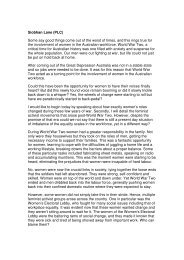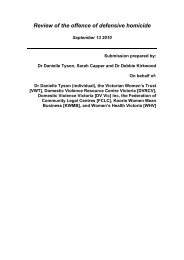<strong>The</strong> Big Pictureforests & fires<strong>The</strong> forest resourceAustralia has about 164 million ha of nativeforest, including rainforest. Most of the trees areon Crown land. Commercial forestry is permittedon about 11.4 million ha of this Crown land andis concentrated in Western Australia, Victoria,Tasmania and New South Wales. Another1.7 million ha of commercial trees are locatedin plantations. 4 Commercial timber harvestingon Crown land is carried out under 20-yearRegional Forestry Agreements between eachstate government and the Commonwealthof Australia. 5<strong>The</strong> forest industries are Australia’s secondbiggestmanufacturing sector, contributingabout only 1% to GDP and about 7% ofmanufacturing output. 6 Forest industries alsoFigure 1. Changes in area plantedto softwoods and hardwoods,1994–2004Since 1994 t<strong>here</strong> has been significantchange in the composition of treeplantations across Australia. Whilethe planting of pines (softwood) hasremained fairly steady, t<strong>here</strong> has beena major increase in the area of landplanted to eucalypt (hardwood) species.This has been occurring in those partsof Australia with the most reliablerainfall.Source: Department of AgricultureFisheries and Forestry – Bureau of RuralSciences, National plantation inventoryAustralia, 2006 Update, p. 1.1,800,0001,600,0001,400,0001,200,000AREA (ha)1,000,000800,000600,000400,000200,0000provide direct employment for approximately80 000 people. 7 This employment is widelydispersed, with employment in many smallcommunities critically dependent upon loggingcontracts, haulage, and jobs in around athousand local saw mills, manufacturingplants and paper mills.<strong>The</strong> move to aregulated industryCommercial harvesting of native timber waswell established in NSW as early as 1820.Port facilities had been constructed in SydneyHarbour, the floodplains of the Parramatta andLane Cove rivers were littered with farms and,as settlers continued to spread out and clearland, ancient stands of red cedar trees wereHardwoodSoftwood1994 1995 1996discovered. Each summer these trees were felledby groups of timber cutters, and cedar becameone of the young colony’s first export products. 8For more than a century, extensive commercialtimber harvesting was a feature of Australia’sdevelopment. Timber was produced for buildingand construction, for railways, ports, roads andmines as well as furniture, paper products andpackaging. During this time, state governmentsintroduced legislation and regulation tomanage logging in each jurisdiction.Today’s forest industry is highly regulated.Most harvesting of native forests is carried outon Crown land in upper catchment areas. Areaswith commercial trees are usually harvestedusing a method called clear-felling, so that mostof the suitable trees are felled at one time. Some1997 1998 1999 2000 2001 2002 2003Yearstime after the sawlogs have been removed, t<strong>here</strong>sidual material is burned and, after rain, theeucalypt seeds germinate. Seedlings are allowedto grow into mature trees which will be harvestedabout 80 years later. 9 Not all forest management,however, observes this rotation interval.Logging is not allowed on steep slopes orclose to the edge of streams. Mature treesthat provide seed for forest regeneration, andalso shelters and nesting sites for wildlife, arepreserved. <strong>The</strong>se regulations are in place toensure that disturbed soil is not washed intothe watercourses of the upper catchment andthat logging impacts upon native fauna aremoderated. Loggers operate under contractswith state governments and their operationsmust comply with prescribed codes of practice.Plantations & farm forestryCommercial timber can be grown either onCrown land or on private land in plantations.Although trees have been grown in plantationsin Australia for about 100 years, t<strong>here</strong> has beena major expansion in the past 10 years, withthe conversion of productive farmland to treeplantations on a large scale.Driving this development was the 2020 VisionStatement, released by the then deputy primeminister, John Anderson, in 1997. This statementproposed that: ‘Plantations have the potentialto be of significant benefit to the naturalenvironment, and a sustainable and viableland use in regional Australia. Commonwealth,state and territory governments have in placea set of national principles for the sustainablemanagement of plantations, providing aframework for environmental, socio-economic38 <strong>Victorian</strong> Women’s <strong>Trust</strong> - Our Water Mark
<strong>The</strong> Big Pictureforests & firesand cultural issues to be addressed in the context of plantationestablishment and management.’ 10 Significantly, the issues of water useand water balance are mentioned in passing only twice in the <strong>document</strong>.Today t<strong>here</strong> are three plantation types: softwood (pine), hardwood(eucalypt), and ‘exotic’ timbers (mixed species). All up, plantations(mainly softwood and hardwood) now cover about 1.7 million ha(or around 3%) of Australia’s agricultural land. Current governmentpolicy settings, incentive schemes and taxation arrangementsare aimed at reaching a target of 3 million ha by 2020. 11Pine plantations (softwood plantations) are now a featureof landscapes in the southeast of the mainland. Large-scaleplantations have been established, mainly on Crown land.<strong>The</strong> volume of production and developments in the chemicaltreatment of the timber means it can be used for a wide rangeof requirements in building and flooring, as structural andfurnishing timber and as packaging. Furthermore, this producthas, in many cases, substituted the use of native forest timbers.Eucalypt plantations (hardwood plantations) account formost of the current expansion. In the last 10 years nearly700 000 ha of new hardwood plantations (41% of the totalplantation area) were established. 12 In 2004–05 alone, over53 000 ha of new eucalypt plantations were planted. 13Plantation eucalypts are usually harvested at around 12 to15 years and converted to woodchips for export. Plantationsof exotic timbers are small scale, long term and high value,aiming to produce timber for furniture products.In the areas w<strong>here</strong> most plantation eucalypts are being established,the young trees have an appreciable water requirement of about1–2 ML per hectare per year. 14 However, in contrast to nativeforests w<strong>here</strong> water uptake from the catchment decreases astrees age, water demand by plantation eucalypts never dropsbecause the short rotation of the plantation cycle means thatthe trees are always young and vigorously growing. 15<strong>The</strong> scale of recent eucalypt plantings on private land is nowattracting attention in rural communities. Serious concerns arenow being expressed about the additional water demand created byplantations and the capacity of catchments to meet this demand. 16In addition, this conversion results in the removal of money fromlocal economies. For instance, a study has shown that for every10 000 ha of dairy farms that were converted to plantationsunder managed investment schemes, $361 million wasremoved from local economies over a period of 11 years. 17Forests & fireOver millennia, Indigenous Australians used fire as a tool tomanage grasslands, forests and fauna. European settlers, fearfulof fire, had to learn to live with naturally occurring bushfires.<strong>The</strong> modern-day response to bushfires is a sophisticatedone, with the goals of protecting life, property and watercatchments. We’re accustomed to seeing television imagesof helicopters dropping water bombs on fire fronts and firecrews quelling spot fires with hoses. Depending upon thecircumstances, the fire may be suppressed or merely contained.We’re also familiar with the response of the bush to a big fire.Immediately following the fire, tree trunks and the land surfaceare blackened. No animals or insects are to be seen and t<strong>here</strong> isa distinctive acrid smell. A few weeks later, green shoots emergeout of the main trunks and branches; a good indicator of whichtrees have survived. New green shoots emerge from the soil and,as soon as it rains, the vegetation bursts into life again. Three to fouryears later the bush looks green again, the insects have returned, thebirds have followed them and native animals are once again visible.What we can’t see is the longer-term impact that thefire will have upon the hydrology of the catchment.When rain falls on a forest soon after a bushfire, surface waterrunoff actually increases for a short period of time. T<strong>here</strong> mayeven be a serious flood because the trees have no canopy, sot<strong>here</strong> are no leaves to absorb water and very little transpiration.As the new growth begins, leaf density in the canopy explodes,transpiration rises and surface water runoff lessens.Table 1. Areas burnt by major fire in Victoria,1939–2007YEARAREA (ha)1939 2 million ha1983 486 000 ha2003 1 300 000 ha2006–07 1 238 000 ha<strong>The</strong> fire of 1939 in Victoria destroyed a forested areaequivalent to nearly one-third the area of Tasmania. <strong>The</strong>three major <strong>Victorian</strong> fires since 1983 have destroyedmore forest area than the fire of 1939.Subsequent regrowth of these forest areas is nowplacing high water demand on catchments. This willcontinue for several decades to come. Future fires willimpose additional demands. Climate change predictionsof hotter summers and drier catchments point toincreased fire risk.Source: <strong>Victorian</strong> Department of Sustainability andEnvironment, Significant fire years, .<strong>Victorian</strong> Women’s <strong>Trust</strong> - Our Water Mark 39






